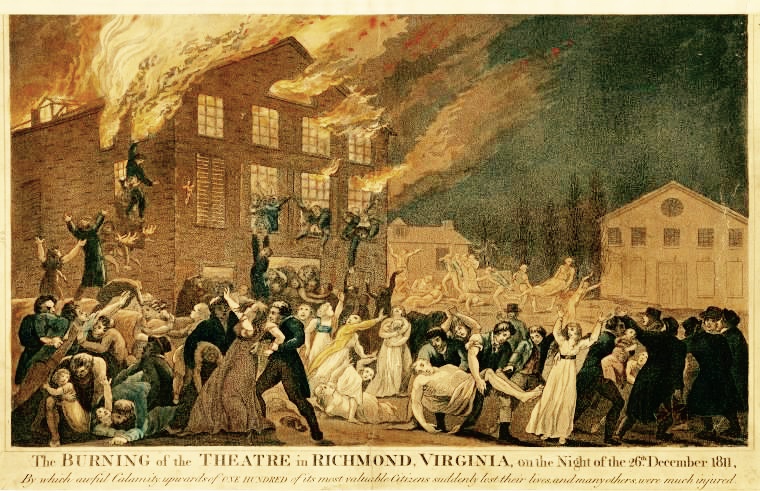
encyclopediavirginia.org
The Richmond Theatre fire, on December 26, 1811, caused the deaths of more than seventy people, including the governor of Virginia. At the time it was the deadliest urban disaster in American history. The five-year-old brick theater, located at the corner of H (later Broad) and Twelfth streets, housed performances by the South Carolina–based Placide and Green Company of actors, who played Richmond from August to December that year. On the night of the fire, more than 600 people, or about 6 percent of the city’s population, packed the poorly designed and poorly constructed building to watch two full-length plays. At the end of the first act of the second play a lit chandelier was mistakenly raised, catching backdrops and then the roof on fire. Those patrons who sat in the two levels of raised boxes were forced to exit down a single, narrow, winding staircase, which soon collapsed. Others threw themselves out second- and third-story windows. George William Smith, elected governor less than three weeks earlier, was among the listed dead, which included at least fifty-four women and many of Richmond’s wealthy elites. Their bodies were interred on the site, and over the crypt the city built Monumental Church, a structure designed by the architect Robert Mills.
“Miraculously Saved”: Richmond and the 1811 Theater Fire
Meredith Margaret Henne
ABSTRACT
The day after Christmas in 1811, the state of Virginia lost her governor and
almost a hundred citizens in a grisly nighttime blaze. The disaster occurred at a poorly
designed, treacherously flammable, and completely packed theater in Richmond, a
Southern city synonymous with entertainment, horse races, and endless balls. Even in a
day when destructive fires were frequent, this fatal conflagration stunned and horrified
Americans like no event in her young history. This particular fire was of a completely
different order—never before had so many American civilians been lost in a single
disaster. Considered America’s first great national tragedy, the Richmond Theater Fire
became the basis for serious personal introspection and public commemoration. As
people sought answers as to why the destruction had happened and what was the right
response to it, the fire became a catalyst for religious change in Richmond, spawning a
renewed interest in church attendance and evangelical Christianity among the leading
members of Virginia’s society that continued for decades. Memorial architecture, copious
printed commentary, exchanges of touching personal letters, rancorous newspaper
editorials, and a score of sermons show how the fire shaped the way Richmond’s
residents interacted with both the theater and the church in the aftermath of the fire.
Richmond’s evangelical churches began to play a more prominent role as cultural centers
for the gentry and middle classes, and congregations grew in size and number. The
theater fire tempered public taste for the theater, as evidenced by reduced attendance,
closings, and an upsurge of anti-theater criticism. However, the tragedy did not
completely obliterate the performing arts as a favorite Richmond pastime, and
Richmond’s theater experienced a return to the realm of acceptable activities in later
years.
Today in Theatre History: THE GREAT RICHMOND THEATRE FIRE–December 26, 1811
padavisblog.wordpress.com
On this day in theatre history—December 26, 1811—occurred one of the greatest theatre calamities in American history: the infamous Richmond Theatre Fire. At the time, it was the worst urban disaster ever in the U.S., killing 72 in all. The fire started after the first act, when a young stagehand, apparently under the thoughtless direction of an overbearing actor, raised the front chandelier before extinguishing the candles. As the chandelier moved up into the fly loft, it set fire to hanging scenery (35 sets in all). The fire spread quickly, as most theatre fires do, filling the house with thick black smoke. The auditorium, nearly sold out, contained 518 adults and 80 children enjoying a Christmas pantomime that had been delayed from the 23rd,, ensuring a full house. Among the audience were a number of Virginia’s political and social elite. Though the facility contained several exits, the doors and hallways were too narrow to accommodate a sudden mass exodus. Many victims were pushed to their deaths from the upper galleries, while others were crushed in the panic downstairs. Among those killed was Virginia’s governor, G. W. Smith.
uvadisasters.fandom.com
Towards the end of the 18th century and into the 19th century, the capital of Virginia began to expand and flourish, attracting many prominent citizens.[1] During the winter of 1811 there was an influx of the upper class that came to Richmond to participate in the social season. One of the popular past times for all the classes in Richmond was attending theater performances. On the night of December 26, 1811 over 600 citizens went to the Richmond Theater to see a performance by the Placid and Green Company. During the performance a fire broke out, setting the entire theater on fire. Most of the lower and middle class held seats on the floor and were able to escape. The wealthy that were sitting in the boxes had a much harder times escaping the fire. After an investigation it was found that 72 people died, including the governor of Virginia, George W. Smith. A large amount of the deceased where part of the upper class. The whole nation was shocked and mourned over the Richmond Theater fire. The Nation also held this event in its memory for decades.[2] Due to the higher regard for the elite the Richmond Theater fire was held in the memories of early Americans because prominent Virginia citizens perished.





